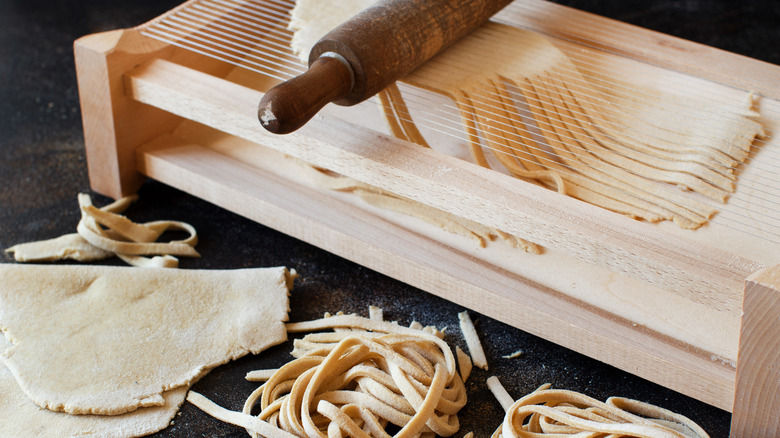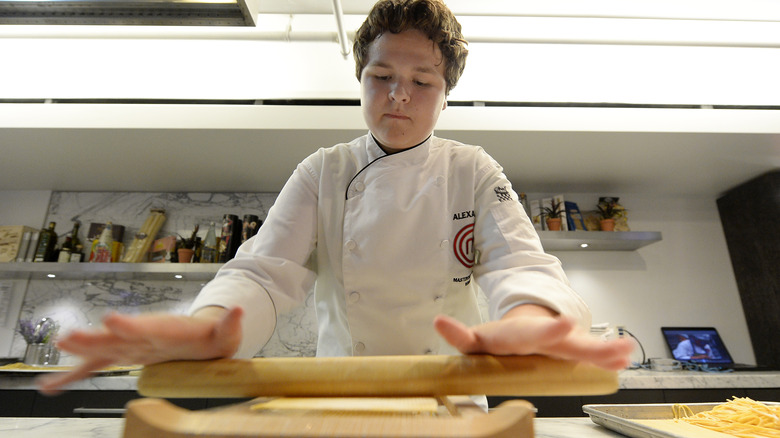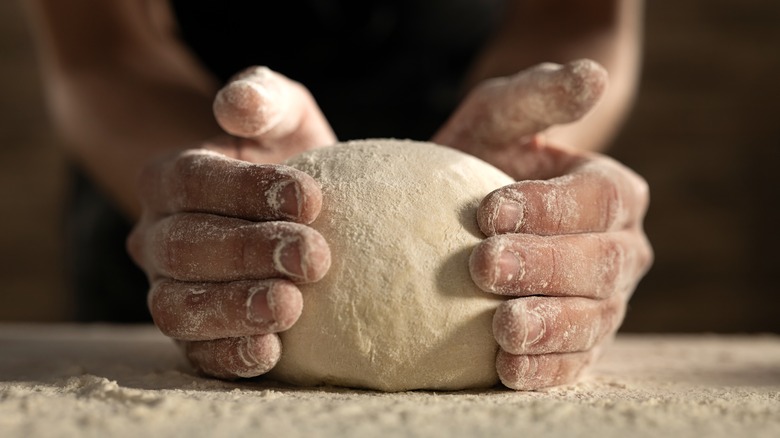The Gadget Every Home Cook Needs For Quicker Fresh Pasta
Dishes like fettuccine alfredo are already marvelous, and making pasta from scratch can help them taste even better. Amateur chefs looking to make perfect pasta from the convenience of their own kitchens don't need bulky, potentially expensive electronics or hours of free time to replicate a nonna's work — the chitarra is a simple, easy-to-use device that can quickly cut dough into flawless strands of varied sizes and shapes.
The chitarra derives its name from the Italian word for "guitar," which is a natural comparison due to both the kitchen tool and the musical instrument using strings to serve their purpose. The wooden pasta-making gadget actually has differently-spaced steel wires on each side, allowing cooks to choose the kind of noodle they desire. Of the two, fettuccine needs no introduction. These wide, flat noodles are great for sopping up rich, thick sauces full of cream or meat. On the other side of the chitarra, you can try your hand at troccoli (or spaghetti alla chitarra, depending on the region), which isn't as common in the U.S. but is a staple in the Puglia region of Italy (called Apulia in English). These noodles are thicker, with a square or oval cross-section, and go well with ragù.
How to use a chitarra
While it may not be a gadget you've heard of before, it's not that hard to find chitarras at a wide range of price points. However, whether you plan on purchasing a simple workhorse tool for under $50 or a handcrafted work of art for closer to $100, it is essential to understand how to properly put the machine to work if you want to get the greatest time savings out of it.
First, make sure you're rolling your dough with the kind of noodle you want in mind. Fettuccini is a wide noodle, so it can be rolled thin. By comparison, the traditional shape of spaghetti alla chitarra means that the dough should be about as thick as the finished noodles will be wide.
Once you have your desired noodle shape figured out, the rolled dough should be placed on the wires of the chitarra on whichever side has gaps of the proper width. From there, guide a rolling pin over the strings to slice the dough into noodles. You can pluck the strings to dislodge any lingering dough, then coat them in a little flour to keep them separated. This machine makes it a cinch to cut a lot of dough with just a little time and effort, meaning fresh pasta at home is a much simpler endeavor.
Making the best dough for your chitarra
Whatever way (and on whichever side of the chitarra) you slice it, good pasta comes from good dough. There are several approaches to creating great pasta, depending on what flavor you want and any dietary restrictions, and most of them can work with this instrument. The simplest version is pasta all'uovo, which uses an entire egg for the liquid. Vegan chefs can opt for pasta bianca, which eliminates the egg in favor of water. Meanwhile, those looking for the richest experience may want to try pasta al tuorlo d'uovo, which only uses egg yolk and creates durable (but potentially brittle) noodles.
The flour used is also important. Type "00" is a fine wheat flour commonly used in Italy, but you can shop for it at specialty stores or online in the United States. Semola, which comes from durum wheat, can be used for more rigid noodle types. If you don't have either of these on hand, all-purpose flour can work just fine, though you may need to fiddle with your recipe's liquid-to-flour ratio to get the right consistency for cutting on your chitarra.
Finally, after putting in all that work, it's time to cook! Don't be afraid to think outside the box. Fettuccini alfredo is a classic for a reason, but interesting alternatives like caramelized onion fettucine can be a mouthwatering use of the same basic pasta, keeping you coming back to your chitarra again and again for more variations.



